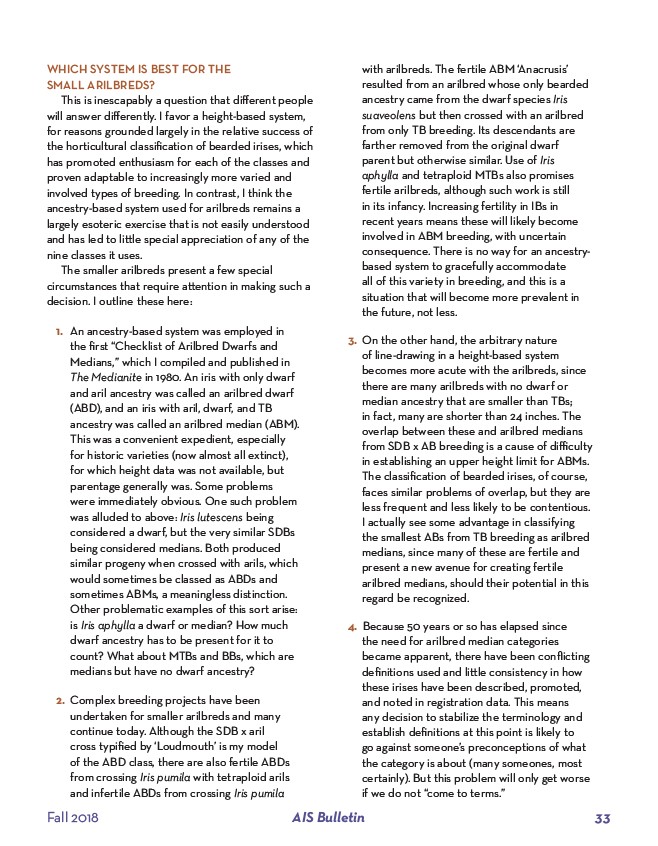
WHICH SYSTEM IS BEST FOR THE
SMALL ARILBREDS?
This is inescapably a question that different people
will answer differently. I favor a height-based system,
for reasons grounded largely in the relative success of
the horticultural classification of bearded irises, which
has promoted enthusiasm for each of the classes and
proven adaptable to increasingly more varied and
involved types of breeding. In contrast, I think the
ancestry-based system used for arilbreds remains a
largely esoteric exercise that is not easily understood
and has led to little special appreciation of any of the
nine classes it uses.
The smaller arilbreds present a few special
circumstances that require attention in making such a
decision. I outline these here:
1. An ancestry-based system was employed in
the first “Checklist of Arilbred Dwarfs and
Medians,” which I compiled and published in
The Medianite in 1980. An iris with only dwarf
and aril ancestry was called an arilbred dwarf
(ABD), and an iris with aril, dwarf, and TB
ancestry was called an arilbred median (ABM).
This was a convenient expedient, especially
for historic varieties (now almost all extinct),
for which height data was not available, but
parentage generally was. Some problems
were immediately obvious. One such problem
was alluded to above: Iris lutescens being
considered a dwarf, but the very similar SDBs
being considered medians. Both produced
similar progeny when crossed with arils, which
would sometimes be classed as ABDs and
sometimes ABMs, a meaningless distinction.
Other problematic examples of this sort arise:
is Iris aphylla a dwarf or median? How much
dwarf ancestry has to be present for it to
count? What about MTBs and BBs, which are
medians but have no dwarf ancestry?
2. Complex breeding projects have been
undertaken for smaller arilbreds and many
continue today. Although the SDB x aril
cross typified by ‘Loudmouth’ is my model
of the ABD class, there are also fertile ABDs
from crossing Iris pumila with tetraploid arils
and infertile ABDs from crossing Iris pumila
with arilbreds. The fertile ABM ‘Anacrusis’
resulted from an arilbred whose only bearded
ancestry came from the dwarf species Iris
suaveolens but then crossed with an arilbred
from only TB breeding. Its descendants are
farther removed from the original dwarf
parent but otherwise similar. Use of Iris
aphylla and tetraploid MTBs also promises
fertile arilbreds, although such work is still
in its infancy. Increasing fertility in IBs in
recent years means these will likely become
involved in ABM breeding, with uncertain
consequence. There is no way for an ancestry-based
system to gracefully accommodate
all of this variety in breeding, and this is a
situation that will become more prevalent in
the future, not less.
3. On the other hand, the arbitrary nature
of line-drawing in a height-based system
becomes more acute with the arilbreds, since
there are many arilbreds with no dwarf or
median ancestry that are smaller than TBs;
in fact, many are shorter than 24 inches. The
overlap between these and arilbred medians
from SDB x AB breeding is a cause of difficulty
in establishing an upper height limit for ABMs.
The classification of bearded irises, of course,
faces similar problems of overlap, but they are
less frequent and less likely to be contentious.
I actually see some advantage in classifying
the smallest ABs from TB breeding as arilbred
medians, since many of these are fertile and
present a new avenue for creating fertile
arilbred medians, should their potential in this
regard be recognized.
4. Because 50 years or so has elapsed since
the need for arilbred median categories
became apparent, there have been conflicting
definitions used and little consistency in how
these irises have been described, promoted,
and noted in registration data. This means
any decision to stabilize the terminology and
establish definitions at this point is likely to
go against someone’s preconceptions of what
the category is about (many someones, most
certainly). But this problem will only get worse
if we do not “come to terms.”
Fall 2018 AIS Bulletin 33